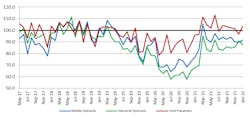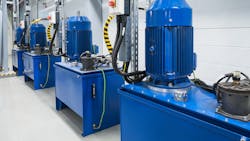The fluid power industry saw positive market conditions in 2021 due in part to growth in the manufacturing and heavy equipment sectors. These markets are expected to remain positive again in 2022 and the coming years, which will continue to benefit hydraulic and pneumatic component manufacturers.
President Joe Biden recently announced his 2023 fiscal year budget priorities, some of which could help boost manufacturing and industrial production in the U.S.—and thus benefit the fluid power industry. Increases in military spending, domestic manufacturing to improve supply chains and workforce development initiatives are just a few of the spending areas included in the budget proposal which may benefit fluid power manufacturers.
Eric Post, senior economist at ITR Economics, said during the National Fluid Power Association’s (NFPA) March 22 economic update webinar that overall total shipments for the fluid power industry are currently up double digits. The industry is seeing a positive growth rate of about 20% year-over-year. The quarterly rate of growth is starting to creep down, however, which he said indicates growth rates will start to decline.
In 2022 and most of 2023 the growth rate will go down. Year-over-year growth of 7% is expected in 2022 compared to 2021 and flat growth in 2023 compared to 2022. A rebound in the growth rate is expected in 2024 as the overall U.S. economy accelerates.
If inflation were to get under control, interest rates do not rise too high, and the conflict between Ukraine and Russia gets resolved quickly, there could be some outperformance of the current ITR Economics forecast, said Post. And conversely, if there are no quick resolutions to the inflation and interest rate pressures or the conflict in Ukraine escalates further, there could be downside risks to the forecast.
Hydraulics to be Aided by Growth in Mobile Equipment Markets
Hydraulic shipments are following a similar trend as the overall fluid power industry. Shipments are nearing their growth rate peak and slowing growth is forecast for most of 2022 and 2023. This segment will bounce back again in 2024.
Construction and agricultural machinery are two of the largest markets hydraulic components sell into. Both have been strong, benefiting hydraulic component manufacturers.
The construction equipment market is currently up 26.9% year-over-year said Post, but on a quarterly basis this segment is up 3.6% for the most recent three months, which shows slowing growth has begun for this market. This is due to slower activity in the residential construction segment. Non-residential, however, is just starting to ramp up, which will provide opportunities for equipment and component manufacturers.
Agricultural equipment is expected to be a mixed bag in 2022, said Post. There was a slight dip in the market in fall of 2021 due to an employee strike at John Deere, but there has been a return to more level conditions. Commodity prices could be positively impacted as more will need to be produced domestically due to the conflict between Ukraine and Russia, which are large food producers.
In general, Post expects 2022 to be a good but not exceptional year for agricultural machinery. There will be growth in this market, just not as much as what was seen in 2021.
North American light vehicle production is essentially flat on a year-over-year basis due to supply chain issues—namely the semiconductor shortage, which has greatly impacted this segment. The semiconductor shortage could go well into late 2022 and into 2023, making recovery in the automotive market a lengthy one.
Material handling is another positive market for the fluid power industry as it is up 19.9% year-over-year. Post noted this is one of the few segments where the quarterly growth rates are coming in stronger than the yearly rate. This is due to lower interest rates and the labor shortage—leading to use of more automated production processes.
This segment will remain positive as more companies move to automation, which will benefit fluid power manufacturers whose components can be used in various material handling equipment. Post believes this segment should have a good long-term outlook and will continue growing.
Heavy truck is up 22.3% year-over-year, but the quarterly rate of change is at 6.1%. Supply chain disruptions are impacting this segment as well, preventing it from being as strong as it could be. But overall, it still has a good growth rate outlook for the coming years.
Goods need to be moved around the country, which will aid demand for trucks. High fuel prices could actually benefit the industry as well by driving fleets to invest in newer, more fuel-efficient truck models.
Growth will also continue for the North American Rotary Rig Count. More U.S. production and export of oil will be necessary due to the conflict between Ukraine and Russia which will benefit this market and those supplying into it. Post said very high growth rates are expected in 2022 and over the next two years.
Machinery New Orders are up 18.8% year-over-year, although Post noted the quarterly growth rate is coming in below the annual growth rate. Slowing growth will be the trend. Mining machinery will have more upside potential in 2022 with the uptick in the oil and gas market, as well.
Medical and Food Production Industries Benefit Pneumatics
Pneumatics are following similar trends as hydraulics. The quarterly growth rate is declining but will remain in positive territory, and is expected to pick up again in 2024.
Supply chain disruptions impacting the automotive market will have the same impact on pneumatics as the hydraulics market. Food processing, a strong market for pneumatics, is expected to follow overall capital goods spending over the next three years, which will be positive for manufacturers serving this market.
Heavy truck is another key segment that again will benefit pneumatics just as it will hydraulics. Fleet demand for new trucks is expected to remain high, particularly with the continued growth of e-commerce, which will bode well for OEMs and component manufacturers.
Medical equipment is just about on the cusp of slowing growth, said Post. The quarterly growth rate is at 5.4%, comfortably below the annual growth rate of 9%. Easing growth rates are anticipated for this market.
Post noted medical and food are markets which do not follow the macro economy like many other markets. They are essential goods people will spend money on no matter what, so they are good areas for fluid power manufacturers to be in if possible.
ITR anticipates the next recession will occur in 2026, possibly starting in late 2025. That is when interest rate and inflationary pressures as well as other market factors could finally impact consumers in a negative way.
But until that time, the majority of the markets in which fluid power manufacturers operate will see slowing growth trends. A few might experience mild recessions, but in general positive conditions are expected even as growth slows.
Material handling and the U.S. infrastructure bill—benefits of which will most likely be seen in 2023 and 2024—will be growth drivers for the fluid power industry. Long-term trends manufacturers can benefit from will include electrification, digitization and the semiconductor market. The need for semiconductor manufacturing will grow as demand for this product is not expected to decline any time soon, which could be a good market for various component manufacturers to supply into.
While markets are expected to be positive through 2024, Post concluded that companies should be cognizant of the potential for recession in late 2025 into 2026. They should be keeping some cash reserves and planning for that, while also ensuring they will be safeguarded should any unexpected disruptions to the global economy occur.
About the Author
Sara Jensen
Executive Editor, Power & Motion
Sara Jensen is executive editor of Power & Motion, directing expanded coverage into the modern fluid power space, as well as mechatronic and smart technologies. She has over 15 years of publishing experience. Prior to Power & Motion she spent 11 years with a trade publication for engineers of heavy-duty equipment, the last 3 of which were as the editor and brand lead. Over the course of her time in the B2B industry, Sara has gained an extensive knowledge of various heavy-duty equipment industries — including construction, agriculture, mining and on-road trucks —along with the systems and market trends which impact them such as fluid power and electronic motion control technologies.
You can follow Sara and Power & Motion via the following social media handles:
X (formerly Twitter): @TechnlgyEditor and @PowerMotionTech
LinkedIn: @SaraJensen and @Power&Motion
Facebook: @PowerMotionTech

Leaders relevant to this article:



